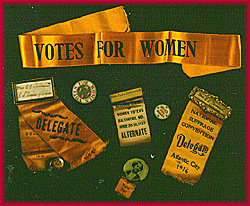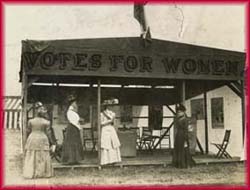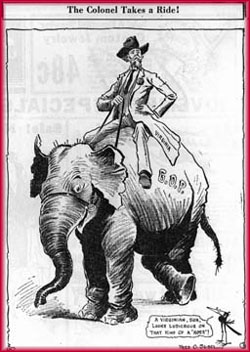|
|
|
|
| |
|
Colonial
Virginia |
American Revolution |
Democratizing the Old Dominion
Civil War and Reconstruction | Virginia
Political Leaders |
|
Twentieth Century |
 |
During
those same decades around the beginning of the twentieth century,
large numbers of Virginia women were organizing to obtain the
right to vote. The woman suffrage movement, which succeeded in
1920 with the adoption of the Nineteenth Amendment, coincided with
major national reform movements seeking to improve public
education, create public health programs, regulate business and
industrial practices, and establish standards and create agencies
to ensure pure food and public water supplies. Public debate on
these issues and simultaneous demands for better roads and public
services transformed politics in Virginia yet again and brought
into the political process people who had not been active
participants during the nineteenth century. |
|
Equal Suffrage League of Virginia
Papers,
ca. 1909-1935, Acc. 22002 |
|
|
|
| The
participation in political activity of increasing numbers of women
and, after World War II, of African Americans tied Virginia
politics to national politics more closely than ever before.
Through such political organizations as the League of Women
Voters, which became one of the state's most influential
political organizations, many Virginians campaigned for issues of
importance to them and their families. Virginians used both the
court system and such political organizations such as the National
Association for the Advancement of Colored People (NAACP) to press
for an end to racial segregation and for the abolition of poll
taxes and other restrictions on access to the political process. |
 |
|
Votes for Women. Photograph.
Courtesy Valentine Museum. |
|
|
 |
By the final decade of the
twentieth century, political life in Virginia scarcely resembled
that of colonial Virginia. Following the abolition of the poll tax
in the 1960s, the passage of the Voting Rights Act of 1965, and
the lowering of the voting age to 18 in 1970, the number of
Virginia voters increased significantly. During the same period,
the growth of the suburbs and the rapid development of Northern
Virginia as a major population center shifted the center of
political gravity in Virginia away from the rural areas and old
cities to the suburbs. African Americans and women won election to
many more local and state offices, and the Republican Party, which
had been weak in Virginia since the 1890s, enjoyed unprecedented
success. The outcome of these trends could be seen most clearly in
two elections.
In 1989 L. Douglas Wilder became the first African American to be
elected governor of a state, and Mary Sue Terry, who was the first
woman to win statewide office in Virginia in 1985 when she was
elected attorney general, was reelected. Eight years later, members of the
Republican Party for the first time won all three statewide
offices in Virginia. Those elections reflect the many complicated
changes taking place in Virginia's political life. |
In 1928 Virginia voted for a
Republican presidential candidate for the first time since 1872.
"The Colonel Takes a Ride!" Fred O. Seibel.
Richmond Times-Dispatch, 9 November 1928.
Courtesy of Special Collections,
James Branch Cabell
Library,
Virginia Commonwealth University. |
|
|
|
| Twentieth
Century Virginia Political Leaders |
|
|

Virginia
Department of Education School Buildings Service Photographs
U.
S. Army Signal Corps Photograph Collection
Charles
F. Gillette Photograph Collection
1939
World's Fair Photograph Collection
|
|